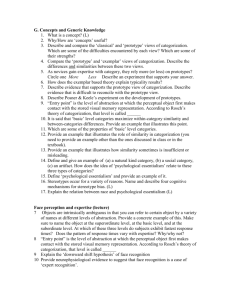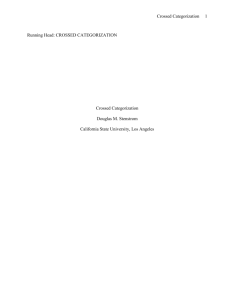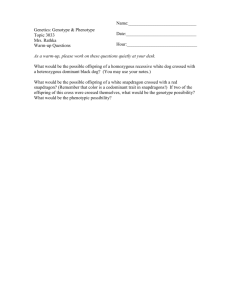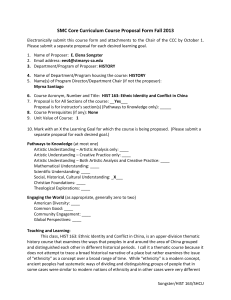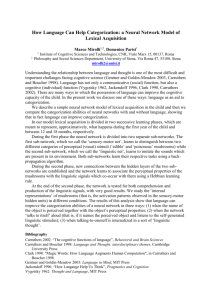Norman, - PsychWiki
advertisement
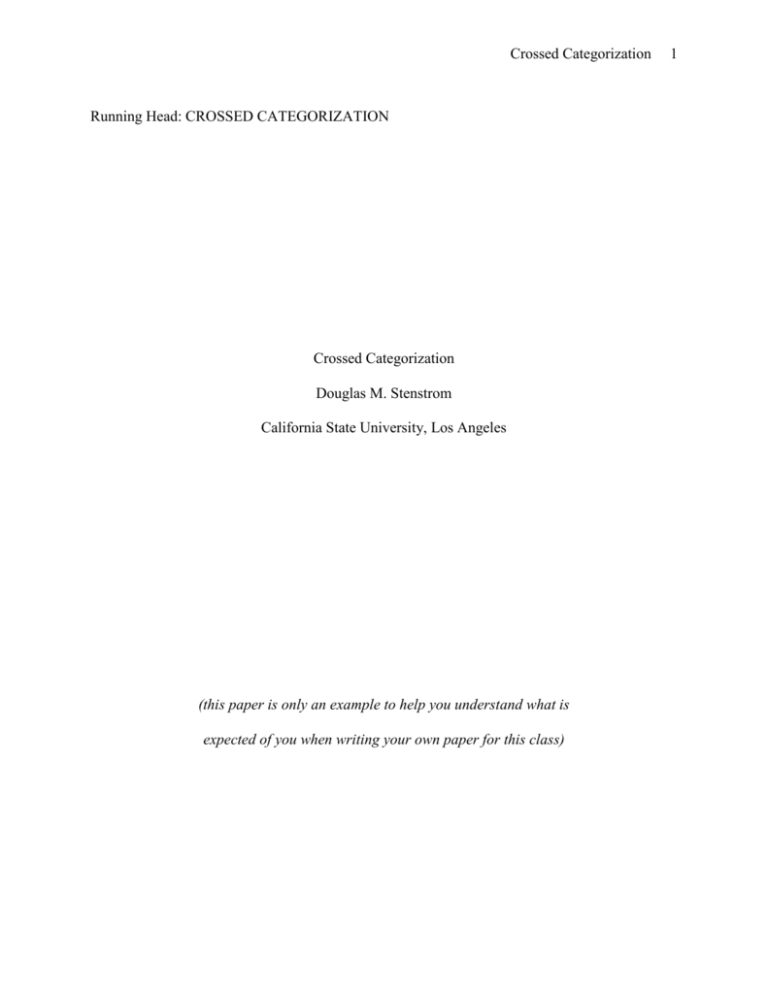
Crossed Categorization Running Head: CROSSED CATEGORIZATION Crossed Categorization Douglas M. Stenstrom California State University, Los Angeles (this paper is only an example to help you understand what is expected of you when writing your own paper for this class) 1 Crossed Categorization 2 Crossed Categorization When we meet someone who differs from us on one dimension of social categorization (outgroup member) but who is similar on another dimension (ingroup member), crossed categorization exists (Crisp & Hewstone, 1999; Urada & Miller, 2000). In the crossed categorization paradigm, orthogonally overlapping two ingroup memberships and two outgroup memberships produces four target groups that participants evaluate: double ingroup (ii), crossed groups (io and oi), and double outgroup (oo) (Migdal, Hewstone, & Mullen, 1998; Miller, Urban, & Vanman, 1998). As an illustration, a participant who is both young and a Democrat is asked to evaluate groups comprised of young Democrats (ii), young Republicans (io), older Democrats (oi), and older Republicans (oo). More recent extensions of the crossed categorization research paradigm have investigated multiple overlapping categories beyond the traditional two-group model (Urada, Stenstrom, & Miller, 2006). In these instances, participants are asked to evaluate people with incrementally more overlapping category memberships, such as oi, oii, oiii, oiiii, and so forth (Crisp, Hewstone, and Rubin, 2001). The purpose behind crossed categorization is to reduce real-world bias, discrimination, and violence. History is replete with instances where people are distinctively categorized on the basis of their race, ethnicity, citizenship, political affiliation, social status, religion, gender, sexual orientation, etc (Urban & Miller, 1998). The result of categorizing people into ingroups and outgroups is group-based animosity, hostility, and violence. Research into social identity has consistently shown that merely categorizing people into "us" vs. "them" or "we" vs. "they" is sufficient to create intergroup bias (Brewer & Miller, 1984), and sometimes even extends to more severe forms of intergroup hostilities and violence as evidenced by real-world identitybased conflicts between nations, ethnic, religious, and political groups (Urada et al., 2006). Crossed Categorization 3 Extreme examples include conflicts with long and intense histories such as Irish Protestants and Catholics, Israeli Palestinians and Jews, and Rwandan Hutus (Urada et al., 2006). However, the same type of ingroup-outgroup categorization also impacts more moderate intergroup strife like Republican-Democrat, Pro Life-Pro Choice, Yankee-Dodgers, and so forth (Crisp et al., 2001). Crossing category memberships within the crossed categorization research paradigm (CC paradigm) has been proposed as a technique for reducing these types of intergroup violence in real-world settings where individuals belong to many different overlapping social categories (Ensari & Miller, 1998). When two people meet, a number of distinct group memberships, such as age, ethnic background, and gender, can become instantly salient even before either person has had a chance to speak. Religious jewelry, dress, and speech accent provide additional immediate cues for category identities (Ensari & Miller, 1998). In other words, people instantly identify multiple overlapping category memberships. Making crossed categorizations salient has been advocated as a potentially effective tool to decrease this intergroup bias by decreasing either category differentiation – a cognitive component, or group identification – a motivational component (Urada et al., 2006). Unlike the targets with convergent group memberships (ii and oo), crossed group membership targets (io and oi) contain conflicting cues about the individual’s group identity (Crisp et al., 2001). As an example, a young Israeli may feel less bias for a group comprised of Palestinians who are also young like the participant because shared membership on one category dimension (young) is in conflict with, and cancels out, the distinctiveness of the other category dimension (ethnicity) (Urada et al., 2006). In this way, sharing an in-group membership with an out-group member (crossing categories) can reduce both the differentiation between the groups (cognitive Crossed Categorization 4 component) and the negative feelings toward the group member (affective or motivational component) (Migdal et al., 1998). Example - Real-Life In a recent news story from CNN entitled “Trapped between worlds, some Latina teens consider suicide” (Yager, 2009), there is an astonishing report from the Centers for Disease Control (CDC) that one out of every seven Latina teens attempts suicide. Why would Latina teens engage in this self-inflicted violence? The research on crossed categorization may help explain the suicides because the news article argues that Latina teens face a conflict between two cultures – the Latino heritage of their parents, and the American culture in which they currently live. The conflict creates feelings of confusion, frustration, and being trapped between the peer-group pressure to fit within the American culture and the family-group pressure to fit within the Latino culture. In other words, the teens are faced with conflicting ingroup-outgroup categorization on a daily basis, and more importantly, they are faced with that cross categorization and discrimination from both cultures. Cross categorization may also help explain how to reduce the conflict. The article reports that one primary explanation for the suicidal behavior is a disconnect between the mothers and daughters, with the daughters feeling overwhelming pressure from their parents to maintain the Latina heritage. Instead of maintaining the perception along ingroup-outgroup lines in which Latina teens are currently being perceived as cultural outgroup members by their mothers, the Latina teens could create shared connections along other lines within the family, thereby creating crossed groups (oi). Alternatively, the Latino teens could try changing how they are perceived to fit each situation, such that within the family they focus on the Latina heritage and within the peer group they focus on the American heritage, thereby priming the shared ingroup Crossed Categorization 5 memberships within the situation. Bicultural individuals, for example, are routinely faced with having to choose between their multiple cultural identities. At any given moment, their focus or perception of themselves and others may be influenced by the combination of group memberships to which they belong and the people or situations in which they are presently surrounded. Consistent with the theorizing behind crossed categorization, the article reported that reducing the perceived disconnect between mothers and daughters was an effective intervention for reducing the incidents of Latina teen suicide. Example - Columbine Can cross categorization help explain the mass killings at Columbine High School by Eric Harris and Dylan Klebold? The original news reports after the massacre were that both boys were social outcasts seeking revenge against the “jocks” who had bullied them unmercifully for years (Chen, 2009). If those news reports were correct, then the research on cross categorization would be relevant by proposing that the act of being bullied categorized Harris and Klebold into an “us” versus “them” mentality that fostered hate and animosity toward their aggressors. According to cross categorization research, people are distinctively classified into an ingroupoutgroup classification on the basis of visible external attributes, such as clothes. The original news reports suggested that Harris and Klebold were part of the “trenchcoat mafia” (Toppo, 2009) which lends support to the theory that both killers were deindividuated into what they perceived as an “outgroup” clique. However, the original news reports were incorrect. The boys were not bullied or part of the “trenchcoat mafia” (Toppo, 2009). Instead, they had a circle of friends, and even went to the prom with a dozen friends in a limo days before they committed the massacre (Chen, 2009). The boys also didn’t target specific groups, such as the jocks, but instead planned to kill Crossed Categorization 6 indiscriminately (Chen, 2009). All of those facts suggest that cross categorization is not a relevant theory to explain the killings by Harris and Klebold because there were no ingroupoutgroup categorizations that fostered an environment of “us” versus “them”. The predominate theory of the killings, instead, is that both boys suffered from clinical disorders such as psychopathy and depression (Toppo, 2009). That said, there is some evidence to suggest that the clinical disorders like psychopathy and depression may have lead to feelings of exclusion and animosity that fueled the rampage. According to evidence discovered after the killings, the last journal entry by Harris read, “I hate you people for leaving me out of so many fun things” (Toppo, 2009). That quote lends support to the theory that social exclusion may be been a precipitating factor for the killings. In Klebold’s journal, he wrote that "I have always been hated, by everyone and everything” (Toppo, 2009). Once again, the extreme level of depression and antipathy toward others may have caused the rampage at Columbine High School. The feelings of “being left out of so many things” and being “hated, by everyone and everything” suggests that the boys perceived themselves as distinct and separate from others into an ingroup-outgroup categorization, consistent with research on cross categorization. If cross categorization was a relevant theory for the Columbine High School killings, then it may also be relevant to reduce similar events in the future. Since people belong to many different overlapping social categorizations, by integrating disaffected teens into one of the available social categorizations within a high school setting may help alleviate the feelings of social exclusion. Joining relevant social and academic-related teams, clubs, cliques, and groups may help decrease category differentiation or group identification, consistent with the research on how cross categorization can reduce intergroup bias and aggression. Crossed Categorization 7 References Brewer, M.B., & Miller, N. (1984). Beyond the contact hypothesis: Theoretical perspectives on desegregation. In N.M. & M.B. Brewer (Eds.), Groups in Contact: The Psychology of Desegregation (pp 281-302). Orlando, FL: Academic Press. Chen, S. (2009). Debunking the myths of Columbine, 10 years later. Retrieved April 5th, 2010 from cnn.com: http://www.cnn.com/2009/CRIME/04/20/columbine.myths/ Crisp, R. J. & Hewstone, M. (1999). Differential evaluation of crossed category groups: Patterns, processes, and reducing intergroup bias. Group Processes and Intergroup Relations, 2, 307-333. Crisp, R. J., Hewstone, M., Rubin, M. (2001). Does multiple categorization reduce intergroup bias? Personality and Social Psychology Bulletin, 27, 76-89. Ensari, N., & Miller, N. (1998). Effect of affective reactions by an out-group on preferences for crossed categorization discussion partners. Journal of Personality & Social Psychology, 75(6) 1503-1527. Migdal, M.J., Hewstone, M., & Mullen, B.M. (1998). The effects of crossed categorization on intergroup evaluations: A meta-analysis. British Journal of Social Psychology, 37, 303324. Miller, N., Urban, L. M., & Vanman, E. J. (1998). A theoretical analysis of crossed categorization effects. In C. Sedikides, & J. Schopler (Eds.), Intergroup cognition and intergroup behavior (pp. 393-420). Mahway, NJ: Earlbaum. Mullen, B., Migdal, M. J., & Hewstone, M. (2001). Crossed categorization versus simple categorization and intergroup evaluations: A meta-analysis. European Journal of Social Psychology, 31, 721-736. Crossed Categorization 8 Toppo, G. (2009). 10 year later, the real story behind Columbine. Retrieved April 5th, 2010 from usatoday.com: http://www.usatoday.com/news/nation/2009-04-13-columbinemyths_N.htm Urada, D.I., & Miller, N. (2000). The Impact of Positive Affect on Crossed Categorization Effects. Journal of Personality and Social Psychology, 78(3), 417-433. Urada, D. I., & Stenstrom, D. M., & Miller, N. (2006). Crossed categorization beyond the two group paradigm. Journal of Personality and Social Psychology, 92, 649-664. Urban, L. M., & Miller, N. (1998). A theoretical analysis of crossed categorization effects: A meta-analysis. Journal of Personality and Social Psychology, 74(4), 894-908. Yager, C. (2009). Trapped between worlds, some Latina teens consider suicide. Retrieved October 24, 2009 from cnn.com: http://www.cnn.com/2009/LIVING/10/24/lia.latina.suicides/
